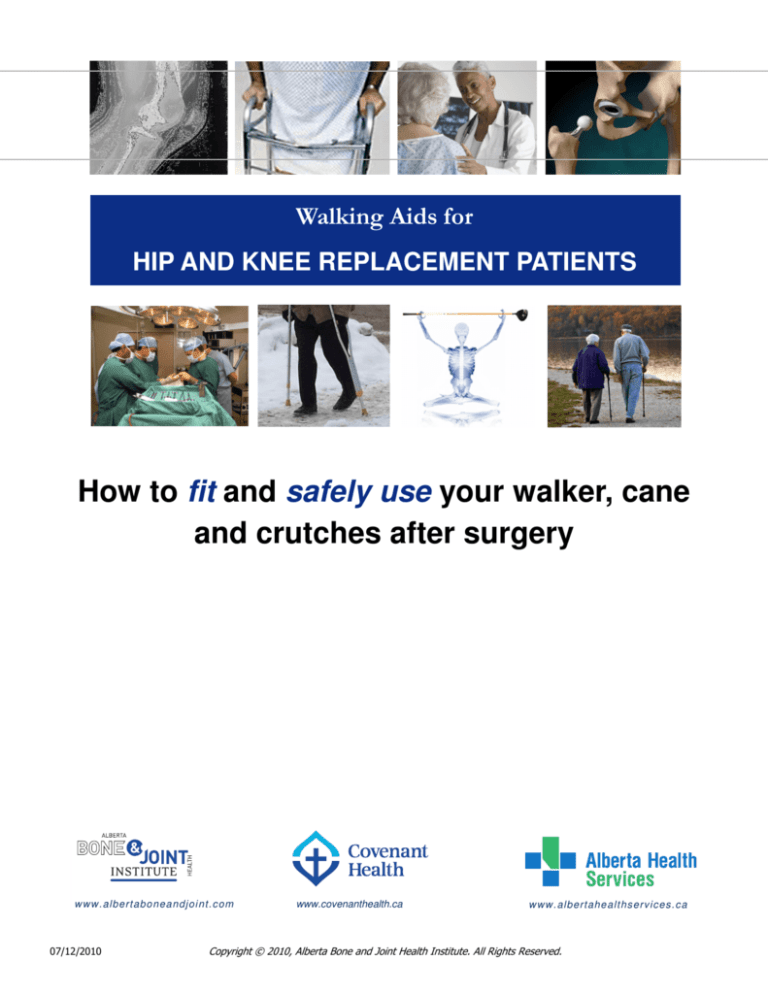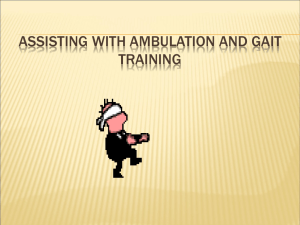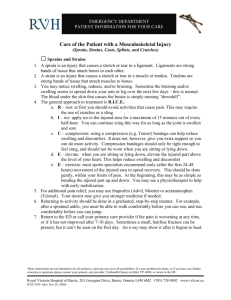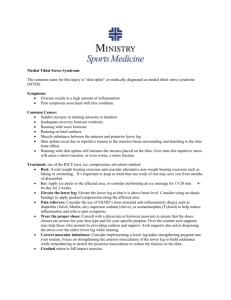
Aids
AWalking
New Knee
forfor
You
YOUR
KNEE REPLACEMENT
HIP
ANDGUIDE
KNEE TO
REPLACEMENT
PATIENTS
How toWhat
fit and
to safely
do anduse
what
your
to expect
walker, cane
and
crutches
before,
during
and after surgery
your surgery
w ww .albertabo nea ndjoi nt.com
07/12/2010
www.covenanthealth.ca
www.albertaboneandjoint.com
w ww .albertahe althservices.ca
Copyright © 2010, Alberta Bone and Joint Health Institute. All Rights Reserved.
Contents
Introduction
1
Know Your Weight Limit
2
Fitting and Using Your Walker
2
Getting the Right Fit
3 Simple Steps to Walking with Your Walker
Getting Up on and Down from a Single Step
or a Curb with Your Walker
Sitting Down and Standing Up with Your Walker
Safety Tips
Fitting and Using Your Cane
Getting the Right Fit
3 Simple Steps to Walking with Your Cane
Sitting Down with Your Cane
Standing Up with Your Cane
Going Up and Down Stairs with Your Cane
Safety Tips
Fitting and Using Your Crutches
Getting the Right Fit
3 Simple Steps to Walking with Your Crutches
Sitting Down with Your Crutches
Standing Up with Your Crutches
Going Up and Down Stairs with Your Crutches
Using a Single Crutch or a Cane
Using a 4-Point Gait with Crutches
Safety Tips
2
3
3
4
4
5
5
6
7
7
8
8
9
9
9
10
10
11
12
13
13
Copyright © 2010, Alberta Bone and Joint Health Institute. All Rights Reserved.
07/12/2010
Introduction
The walking aids you will use after your hip or knee replacement are very
important tools for your successful recovery from surgery. Whether you are
going to use crutches, a cane, a walker or all of these aids, making sure they
are fitted properly for you and using them the right way will make getting
around easier and safer.
Walking, sitting down, standing up, bending, going up and down stairs – these
are simple activities that must be done safely with the help of walking aids. You
must learn to do these everyday activities without putting more weight on your
operated leg than you can tolerate without limping or than allowed by your
surgeon.
Your physical therapist will teach you to use your walking aids safely. It is
important that you continue to use them until your surgeon or physical therapist
tells you they are no longer needed.
It is best to have your walking aids 1 to 2 weeks before your surgery so that
you can practice using them. Practicing ahead of time will help you to manage
more easily and safely once you return home from the hospital.
Remember – make safety your main concern. Remove loose mats and rugs,
electric cords and cables that could cause you to trip or slip in your home.
Most walking aids can be bought or rented from a medical and surgical supply
store. These stores are listed in the Yellow Pages phone book under Home
Health Care Supplies. To save shopping around, you can buy crutches at the
hospital on the day you arrive for surgery, unless you need special crutches for
your height or weight. Many pharmacies rent crutches and walkers. In some
areas, walking aids can be borrowed through a medical equipment loan
program.
If you plan to borrow walking aids from friends or family, make sure they are in
good working order and safe, and are the right type for your height and weight.
The information in this booklet is of a general nature. Some of this information
may not apply to you if you have special needs or circumstances. Talk to your
physician or other appropriate health care professional if you have any
concerns or questions.
Please bring this booklet with you when you visit the Hip and Knee
Replacement Clinic, attend therapy sessions and go to the hospital.
07/12/2010
Copyright © 2010, Alberta Bone and Joint Health Institute. All Rights Reserved.
1
Know Your Weight Limit
Your doctor will tell you how much weight you can put on your sore leg when
using your walking aids. There are four types of weight limit:
1. Non-weight Bearing – No weight is allowed on the sore leg and it must be
kept off the floor.
2. Feather Weight Bearing – The toe of the sore leg can be touched to the
floor for balance only but not to hold any weight.
3. Partial Weight Bearing – Up to half the patient’s weight can be put on the
sore leg.
4. Weight Bearing as Tolerated – Most or all of the patient’s weight can be
put on the sore leg.
Fitting and Using Your Walker
Getting the Right Fit
• Put on the shoes you will be wearing when you use your walker.
• Stand up straight.
• Put your walker in front of and partially around you.
• Let your arms hang by your sides with your elbows bent slightly. The
hand grips on your walker should be at wrist level. Adjust the height
of the walker if the hand grips are not at wrist level.
• With the height adjusted, put both hands on the walker’s hand grips
(see picture).
2
Copyright © 2010, Alberta Bone and Joint Health Institute. All Rights Reserved.
07/12/2010
3 Simple Steps to Walking with Your Walker
Standing straight with the walker in front of and partially
around you, follow these 3 easy steps:
1. Move the walker one step length ahead of you. Put all
four legs of the walker on the floor. (Do this the same
way if your walker has two wheels.)
2. Move your sore leg forward and push down on the
walker using your arms.
3. Move your good leg forward so that it is even with or
slightly ahead of your sore leg.
Repeat these steps – 1) walker, 2) sore leg, 3) good leg – to
continue walking.
Remember – put only as much weight on your sore leg as you can
tolerate without limping or as allowed by your doctor.
Getting Up on and Down from a Single Step or a Curb
with your Walker
Always use your walker to get up on or down from a single step or a curb.
Here is how to do this safely:
1. Walk as close as you can to the curb or step.
2. Once you feel steady, lift the walker onto the step.
3. Step up, putting your good leg up first.
4. Raise your sore leg onto the step.
5. To step down, place the walker down to the bottom edge of the step. Put
your sore leg down first and then step down with your good leg.
Remember – never use your walker to go up or down more than a single
step, and put only as much weight on your sore leg as you can tolerate
without limping or as allowed by your doctor.
07/12/2010
Copyright © 2010, Alberta Bone and Joint Health Institute. All Rights Reserved.
3
Sitting Down and Standing Up with Your Walker
1. Find a steady chair with solid armrests or sides. Stand with
your back to the chair and with the walker close to you.
2. Place the back of your good leg against the chair.
3. Slide your sore leg forward slightly.
4. Place both hands on the armrests or sides of the chair.
5. Lower yourself gently onto the chair.
6. Slide back in the chair until you are comfortable.
Do the reverse to stand up.
Remember – never use an unstable chair or one that is
very low and be careful not to put more weight on your sore leg than you
can tolerate without limping or than allowed by your doctor.
Safety Tips
√ Always wear shoes with good support. Do not wear slippers.
√ Check the condition of the rubber tips on the walker. Replace them if they are
worn or in poor condition.
√ Do not place the walker too far ahead when walking. A good rule is to place
the walker no more than one step length in front of you.
√ Do not step too far into the walker when walking. Stepping too far into the
walker may cause you to lose your balance.
√ Do not lean on the walker when getting up or sitting down. Leaning on the
walker could cause it to tip over.
√ Avoid wet surfaces – they can be slippery. Take small steps if you must walk
on a wet or slippery surface.
√ Remove loose mats and rugs, electric cords and cables. They could cause
you to trip or slip.
√ Never use your walker on stairs.
Note: Use your walker until your doctor or physical therapist tells you it is no
longer needed.
4
Copyright © 2010, Alberta Bone and Joint Health Institute. All Rights Reserved.
07/12/2010
Fitting and Using Your Cane
Getting the Right Fit
• Put on the shoes you will be wearing when you use your cane.
• Stand up straight and relax your shoulders.
• Hold the cane in the hand opposite your sore leg – in the right
hand if your left leg is sore; in the left hand if your right leg is
sore.
• Place the cane about 10 cm (4 in.) from the side of your good leg.
Stand so that your weight is spread evenly between your feet and
your cane. Do not put more weight on your sore leg than you can
tolerate without limping or than allowed by your doctor.
• Let the hand you are using to hold the cane drop down by your
side with your elbow bent slightly. The hand grip on the cane
should be at wrist level. If the hand grip is not at wrist level, adjust
the cane’s height by:
⇒ Pushing in the button and sliding the tubing in or out if you
are using an adjustable cane.
⇒ Cutting the cane to the proper length if it is wooden.
07/12/2010
Copyright © 2010, Alberta Bone and Joint Health Institute. All Rights Reserved.
5
3 Simple Steps to Walking with Your Cane
Standing straight with the cane about 10 cm (4 in.) from the side of your good
leg, follow these three steps:
1. With your cane in the hand opposite your sore leg, shift your weight to the
good leg and move the cane 10 cm in front of your foot.
2. Move your sore leg forward so the foot is even with the cane.
3. Shift your weight to your sore leg and the cane. Move the good leg forward
so the foot is ahead of the cane.
Repeat these steps – 1) cane forward, 2) sore leg forward and in line with cane,
3) good leg forward ahead of cane – to continue walking.
Remember – keep your back straight and your stomach muscles tight
when taking each step and put only as much weight on your sore leg as
you can tolerate without limping or as allowed by your doctor.
1
Moving your cane forward
2
3
Moving your sore leg forward
Moving your good leg forward
Sore leg
Good leg
6
Cane
Cane
Copyright © 2010, Alberta Bone and Joint Health Institute. All Rights Reserved.
Cane
07/12/2010
Sitting Down with Your Cane
1. Find a steady chair with solid armrests or sides. Using your
cane, stand with the back of your legs lightly touching the chair.
2. Move the cane out from your side – lean it on
the chair and reach back with both hands to
grab onto the armrests or the seat of the
chair.
3. Slide your sore leg forward.
4. Lower yourself gently onto the chair.
5. Move back in the chair until you are comfortable.
Never sit in an unstable chair or one that is very low.
Standing Up with Your Cane
1. To get out of the chair, place your cane on the end of the
armrest or in your hand.
2. Move closer to the edge of the chair seat and move your
heels close to the base of the chair.
3. Push down on the armrests or seat of the chair and lean
forward slightly.
4. Put your sore foot forward slightly and push yourself up with
your good leg and arms.
5. Steady yourself. Move the cane’s tip to about 10 cm (4 in.)
from the side of your good leg.
Remember – be careful when sitting down and standing
up not to put more weight on your sore leg than you can
tolerate without limping or than allowed by your doctor.
07/12/2010
Copyright © 2010, Alberta Bone and Joint Health Institute. All Rights Reserved.
7
Going Up and Down Stairs with Your Cane
To Go Up the Stairs
1. Stand close to the bottom step.
2. If there is a handrail, hold onto it after checking that it is solid
and safe. Hold the cane in your other hand.
3. Lift your good leg to the first step. Make sure to balance your
weight between the cane and the handrail.
4. Lift your cane and sore leg to the first step using the handrail
to help lift your weight. You should now be standing on the first
step with both legs and your cane.
Go up one step at a time this way.
To Go Down the Stairs
1. Making sure you feel secure and steady, stand close to the
edge of the first step. If there is a handrail, hold onto it and
hold the cane in your other hand.
2. Lower your cane and sore leg onto the first step.
3. Lower your good leg onto the same step.
Go down one step at a time this way making sure you are
steady on your feet for each step.
Remember – do not put more weight on your sore leg than
you can tolerate without limping or than allowed by your doctor.
Safety Tips
√ Always wear non-skid shoes with good support. Do not wear open-heeled
sandals, clogs or slippers.
√ Make sure the cane tip is wearing evenly and is not cracked or torn.
√ Avoid wet surfaces – they can be slippery. Take small steps if you must walk
on a wet or slippery surface.
√ Attach an ice pick to the end of your cane if you are using it in winter.
√ Remove loose mats and rugs, electric cords and cables. They could cause
you to trip or slip.
Note: Use your cane until your doctor or physical therapist tells you it is no
longer needed.
8
Copyright © 2010, Alberta Bone and Joint Health Institute. All Rights Reserved.
07/12/2010
Fitting and Using Your Crutches
Getting the Right Fit
• Stand up straight placing the crutches
under your armpits and the ends 13 cm to
20 cm (5 in. to 8 in.) from the side of each
foot.
• The crutches are the right length for you if
there is space of about 2 to 3 finger widths
between the crutch pad at the top and
your armpit.
• The hand grips should be at wrist level
when your arms are hanging by your
sides. Your elbows should be bent slightly
when you grab and push down on the
hand grips.
• Adjust the length of the crutches and position of the hand grips if necessary.
3 Simple Steps to Walking with Your Crutches
Stand straight and place the crutches ahead and to the sides of your feet for
balance. Squeeze the crutches into your ribs by putting your weight on your
hands while holding the hand grips and keeping your elbows straight. Follow
these 3 steps:
1. Move both crutches forward at the
same time.
2. Move your sore leg forward between
the crutches.
3. Move your good leg ahead of the
crutches.
Repeat these steps – 1) crutches, 2) sore
leg, 3) good leg – to continue walking.
1
07/12/2010
2
3
Remember – do not lean on the crutch
tops and put only as much weight on
your sore leg as you can tolerate
without limping or as allowed by your
doctor.
Copyright © 2010, Alberta Bone and Joint Health Institute. All Rights Reserved.
9
Sitting Down with Your Crutches
Find a steady chair with solid
armrests or sides.
1. Standing with your crutches and
with your back to the chair, step
back until your good leg touches
the front of the chair.
2. Keeping your weight on your
good leg, remove the crutches
from your arms. Hold both
crutches in one hand grabbing
them by the hand grips.
1
2
3
4
3. Lean forward and bend your good leg. Hold the armrest or chair seat with
the other hand. Slide your sore leg forward.
4. Sit down slowly. Keep your crutches next to the chair.
Never sit in an unstable chair or one that is very low.
Standing Up with Your Crutches
Make sure the chair is steady before you try to stand.
1. Move forward to the edge of the chair so your good foot is flat on the floor.
2. Hold both crutches in one hand grabbing them by the hand grips. Hold the
armrest or seat with the other hand.
3. Stand up taking your weight on your
good leg. Put the crutches under
your arms once you are steady on
your feet.
Remember – be careful when sitting
down and getting up not to put more
weight on your sore leg than you
can tolerate without limping or than
allowed by your doctor.
1
10
2
3
Copyright © 2010, Alberta Bone and Joint Health Institute. All Rights Reserved.
07/12/2010
Going Up and Down Stairs with Your Crutches
A handrail makes going up and down stairs with crutches much safer. Use a
handrail only after first checking that it is solid and safe. Have a handrail
installed, if possible, on any stairway you must use in your home that does not
have one.
To Go Up the Stairs
Stand close to the bottom step and
close to the handrail.
Put both crutches under the arm
opposite the handrail so that you
are using them together as one
(see picture). Hold onto the
handrail with your free hand.
1. Raise your good leg and put
your foot on the first step.
1
2
3
2. Lean forward taking your weight on your good leg.
3. Lift your sore leg and the crutches to the first step.
Go up the stairs this way only one step at a time making sure you are
secure and steady before taking each step. If someone is helping you, have
your helper stand behind and to your side.
To Go Up the Stairs without a Handrail
If you must go up a stairway that does not have a handrail:
1. Stand close to the bottom step with one crutch under each arm.
2. Raise your good leg placing your foot solidly on the first step.
3. Lean forward taking your weight on your good leg.
4. Lift your sore leg and the crutches to the first step.
Go up the stairs this way only one step at a time making sure you are secure
and steady before taking each step. If someone is helping you, have your
helper stand behind and to your side.
07/12/2010
Copyright © 2010, Alberta Bone and Joint Health Institute. All Rights Reserved.
11
To Go Down the Stairs
Making sure you are steady, stand close to the edge of the top step and close
to the handrail.
Put both crutches under the arm opposite the handrail so that you are using
them together as one (see picture). Hold onto the handrail with your free hand.
1. Move your hand down the
handrail and lower your
crutches to the first step.
2. Lower your sore leg placing
your foot on the first step.
3. Step down with your good leg.
1
2
3
Go down the stairs this way only
one step at a time making sure
you feel secure and steady before
taking each step. If someone is
helping you, have your helper
stand in front and to your side.
To Go Down the Stairs without a Handrail
If you must go down a stairway that does not have a handrail:
1. Making sure you feel steady, stand close to the edge of the top step with
one crutch under each arm.
2. Put both crutches on the first step below but keep the upper end of the
crutches tilted back toward your arms.
3. Lean forward and crouch slightly until the tops of the crutches are against
your armpits.
4. Lower your good leg placing your foot down solidly on the step first.
5. Lower your sore leg to the same step.
Go down the stairs this way only one step at a time making sure you are
secure and steady before taking each step. If someone is helping you, have
your helper stand in front and to your side.
Using a Single Crutch or a Cane
You may have to use just one crutch or a cane during recovery from hip or
knee replacement. Always use a single crutch or cane in the hand opposite
your sore leg. This gives you better support and helps you walk more normally.
12
Copyright © 2010, Alberta Bone and Joint Health Institute. All Rights Reserved.
07/12/2010
Using a 4-Point Gait with Crutches
The 4-point gait is a very stable way of walking with crutches. There are four
points of contact with the floor – each crutch and each foot – to support the
patient’s weight. It can be used only by patients who can put some weight on
their sore leg – either partial weight bearing or weight bearing as tolerated (see
page 2).
Use the 4-point gait only if allowed by your physical therapist. If you are going
to use this way of walking with crutches, your physical therapist will give you
instructions in partial weight bearing or weight bearing as tolerated.
To walk using the 4-point gait:
1. Move one crutch forward.
2. Move the opposite foot forward so it is even with the crutch.
3. Move the other crutch forward.
4. Move the opposite foot forward so it is even with the crutch.
Repeat these steps – 1) crutch, 2) opposite foot, 3) other crutch, 4) opposite
foot – to continue walking.
Safety Tips
√ Make sure your crutches have rubber tips, padded tops and secure hand
grips. Keep them in good condition. Replace them when they are worn or
damaged.
√ Numbness or tingling below your armpits or in your upper arms is a sign you
are not using your crutches the right way.
√ Always wear shoes with good support or leave your feet bare. Do not wear
slippers.
√ Use a waist pouch instead of a purse.
√ Avoid wet surfaces – they can be slippery. Take small steps if you must walk
on a wet or slippery surface.
√ Remove loose mats and rugs, electric cords and cables. They could cause
you to trip or slip.
Note: Use your crutches until your doctor or physical therapist tells you they
are no longer needed.
07/12/2010
Copyright © 2010, Alberta Bone and Joint Health Institute. All Rights Reserved.
13
Walking Aids for HIP AND KNEE
REPLACEMENT PATIENTS belongs to:
Name:
Phone:
Address:
Alberta Bone and Joint Health Institute (ABJHI) is a catalyst for improved bone
and joint health care in Alberta. A not-for-profit charitable organization, ABJHI’s
goal is a sustainable system of patient-centred health care delivery that
efficiently provides the best quality of bone and joint care to all Albertans. Find
more information about ABJHI at www.albertaboneandjoint.com.
Copyright © 2010, Alberta Bone and Joint Health Institute. All Rights Reserved.
07/12/2010







